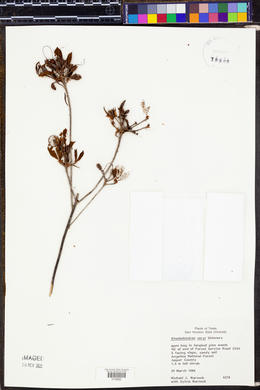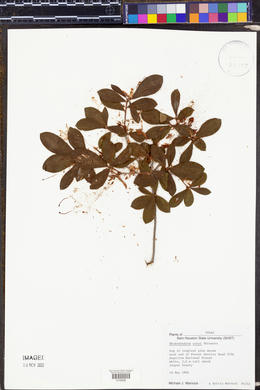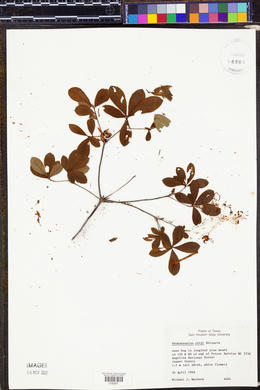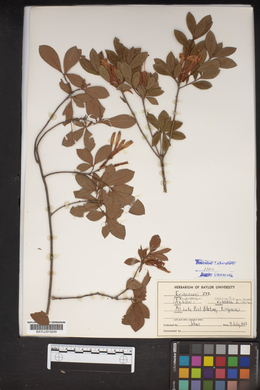Rhododendron viscosum
|
Rhododendron viscosum Torr.
 (redirected from: Rhododendron viscosum var. serrulatum (Small) H.E.Ahles) (redirected from: Rhododendron viscosum var. serrulatum (Small) H.E.Ahles) |
|
|
Family: Ericaceae
Clammy Azalea, more...swamp azalea
[Azalea glauca Lam., moreAzalea hispida Pursh, Azalea nitida Pursh, Azalea oblongifolia Small, Azalea serrulata Small, Azalea viscosa L., Azalea viscosa var. aemulans (Rehder) Ashe, Azalea viscosa var. montana (Rehder) Ashe, Rhododendron coryi Shinners, Rhododendron hispidum (Pursh) Torr., Rhododendron nitidum (Pursh) Torr., Rhododendron serrulatum (Small) Millais, Rhododendron viscosum var. aemulans Rehder, Rhododendron viscosum var. glaucum (Michx.) Torr., Rhododendron viscosum var. montanum Rehder, Rhododendron viscosum var. nitidum (Pursh) A.Gray, Rhododendron viscosum var. serrulatum (Small) H.E.Ahles, Rhododendron viscosum var. tomentosum Rehder in E.H.Wilson & Rehder, Rhododendron viscosum var. viscosum] |
Shrubs or trees, to 7 m, rhizomatous or not. Stems: bark smooth to vertically furrowed, shredding; twigs sparsely to conspicuously multicellular eglandular-hairy (hairs unbranched), otherwise glabrous or densely unicellular-hairy. Leaves deciduous; petiole usually multicellular eglandular-hairy and unicellular-hairy; blade ovate to obovate, 2-7(-9) × 1-3(-3.8) cm, ± thin, membranous to chartaceous, margins entire or, sometimes, minutely serrulate, plane, ciliate, eglandular-hairy, apex acute to obtuse, often mucronate, abaxial surface glabrous or densely unicellular-hairy, adaxial surface (lustrous or dull), glabrous or sparsely scattered eglandular-hairy, sometimes also sparsely unicellular-hairy. Floral bud scales glabrous or densely unicellular-hairy abaxially (sometimes with sharply marked, dark brown band along distal margins), margins unicellular-ciliate or, sometimes, glandular-serrulate. Inflorescences 3-14-flowered; bracts similar to bud scales. Pedicels 5-27 mm, stipitate-glandular- or, sometimes, eglandular-hairy, otherwise sparsely to densely unicellular-hairy. Flowers opening after leaves, erect to horizontal, slightly to strongly fragrant (most noticeable at night); calyx lobes 0.5-5 mm, surfaces and margins scattered stipitate-glandular-hairy or, sometimes, eglandular-hairy, often also unicellular-hairy; corolla white, sometimes pink-tinged or pink (not strongly contrasting with white or greenish to pinkish style or filaments), without blotch on upper lobe, funnelform, 20-58 mm, usually scattered, often conspicuously stipitate-glandular-hairy (hairs continuing in lines up lobes), otherwise sparsely to moderately unicellular-hairy on outer surface, petals connate, lobes 7-21 mm, tube usually ± gradually expanded into lobes, 13-37 mm (equaling or much longer than lobes); stamens 5, much exserted, ± unequal, 21-65 mm. Capsules borne on erect pedicels, 7-20 × 3-7 mm, usually densely stipitate-glandular- and/or eglandular-hairy, otherwise densely unicellular-hairy to ± glabrous. Seeds without distinct tails, flattened portion of testa well developed at each end; testa expanded, dorsiventrally flattened, ± loose. 2n = 26. Flowering spring-summer. Acid swamps, bogs, seepage slopes, pocosins, streamheads and baygalls, wet pine flatwoods, moist pine or pine/oak forests, hummocks, shrub balds; 0-1500 m; Ala., Ark., Conn., Del., Fla., Ga., La., Maine, Md., Mass., Miss., N.H., N.J., N.Y., N.C., Okla., Pa., R.I., S.C., Tenn., Tex., Vt., Va. Rhododendron viscosum is the most widespread and variable species of sect. Pentanthera and has been divided into as many as four species: R. coryi, R. oblongifolium, R. serrulatum, and R. viscosum in the narrow sense. In addition, minor varieties and forms have been described. Because correlated or geographically coherent sets of character states cannot be discerned within this species, infraspecific taxa are not recognized here (K. A. Kron 1993). Rhododendron viscosum is most closely related to R. arborescens, and possibly also R. atlanticum. Hybrids with R. cumberlandense and R. arborescens are known. Plants with white corollas and a yellow blotch may be the result of hybridization.
Shrub 1-2 m, often colonial, much branched and with ±setose-pubescent young twigs; lvs 3-6 cm, setose-hairy, not glandular, oblanceolate to obovate, acute to rounded and mucronulate; bud-scales broadly rounded; fls spicy-fragrant; pedicels and cor-tube stipitate-glandular and minutely hairy; sep minute; cor white (pink), 2-4 cm wide, the tube 2-3 cm, the lobes 1.5-2 cm; style projecting 1-5(-10) mm beyond the anthers at anthesis, usually puberulent for 1 cm or more at the base. Wet woods and swamps; Me. to O. and Fla. June, July. (Azalea v.) Gleason, Henry A. & Cronquist, Arthur J. 1991. Manual of vascular plants of northeastern United States and adjacent Canada. lxxv + 910 pp. ©The New York Botanical Garden. All rights reserved. Used by permission. Tall shrub or small tree to 7 m; setae of the young twigs often more appressed than in no. 8 [Rhododendron viscosum (L.) Torr.], or the twigs merely puberulent, lvs 3-6 cm, narrowly obovate, acute or obtuse; bud-scales, especially the inner, acute and aristate; pedicels and cor-tube stipitate-glandular and minutely hairy; cor white, 2.5-3 cm wide, the tube 2.5-3 cm, at least twice as long as the lobes; style at anthesis projecting 1 cm beyond the anthers, usually glabrous, or puberulent only at the very base. Wet woods on the coastal plain; se. Va. to Fla. and La. June, July. (Azalea s.) Perhaps better treated as R. viscosum var. serrulatum (Small) Ahles. Gleason, Henry A. & Cronquist, Arthur J. 1991. Manual of vascular plants of northeastern United States and adjacent Canada. lxxv + 910 pp. ©The New York Botanical Garden. All rights reserved. Used by permission. |






















































































